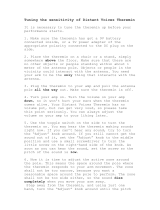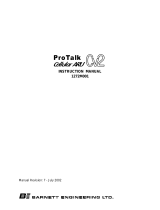
A-108
6/12/24/48 dB Low Pass
System A - 100
doepfer
6
5. User Examples
The filter’s cut-off frequency can be modulated in
various ways: e.g. ADSR (A-140, A-141, A-142), LFO
(A-145, A-146, A-147), Sample & Hold (A-148), Ran-
dom (A-118), Joy-Stick (A-174), Theremin (A-178),
Ribbon (A-198) or via MIDI (A-190/A-191). Many of
these examples can be found in the manuals of the
other filters of the A-100 system.
One special feature of the A-108 is the external
feedback input. This enables the insertion of any
audio processing module into the feedback path. In-
serting a VCA leads to voltage controlled resonance.
In this case the control voltage of the VCA works as
voltage control input for the filter’s resonance. Other
modules that are suitable for insertion are e.g. phaser
(A-125), frequency shifter (A-126), waveform proces-
sor/distortion (A-116, A-136) or even other filters.
Another example is a filter with voltage controlled
cut-off slope
in combination with the voltage control-
led mixer A-135 and the morphing controller A-144.
Fig. 5 shows the corresponding patch.
The four low pass outputs (6/12/24/48 dB) of the A-108
are connected to the four audio inputs of the voltage
controlled mixer A-135.
The levels of the four mixer paths are controlled by the
control voltages coming from the morphing controller
A-144. The audio output signal of the filter with voltage
controlled cut-off slope is available at the output of the
voltage controlled mixer A-135.
The control voltage that is used to control the cut-off
slope is connected to the control voltage input of the
morphing controller A-144. That way it is possible to
sweep the cut-off slope from 6 ... 48dB (fig. 5,
2) with
the control voltage applied to the CV input of the
A-144. In the example the voltage is generated by a
joy stick (A-174) and called “character modulation”. Of
course any other control voltage (e.g. LFO, ADSR,
MIDI-to-CV, Theremin, Random) could be used to
control the “character”, i.e. the cut-off slope. For more
examples please refer to the A-144 user’s manual.
The patch in fig. 5 has these control inputs available:
• Char. Mod.
filter cut-off slope
• Freq. Mod. 1 filter frequency 1 (e.g. ADSR)
• Freq. Mod. 2 filter frequency 2 (e.g. LFO)
If the 48dB low pass output of the A-108 is connected
to the feedback input of the A-108 through a VCA even
the resonance is voltage controlled (= control voltage
of the VCA).















